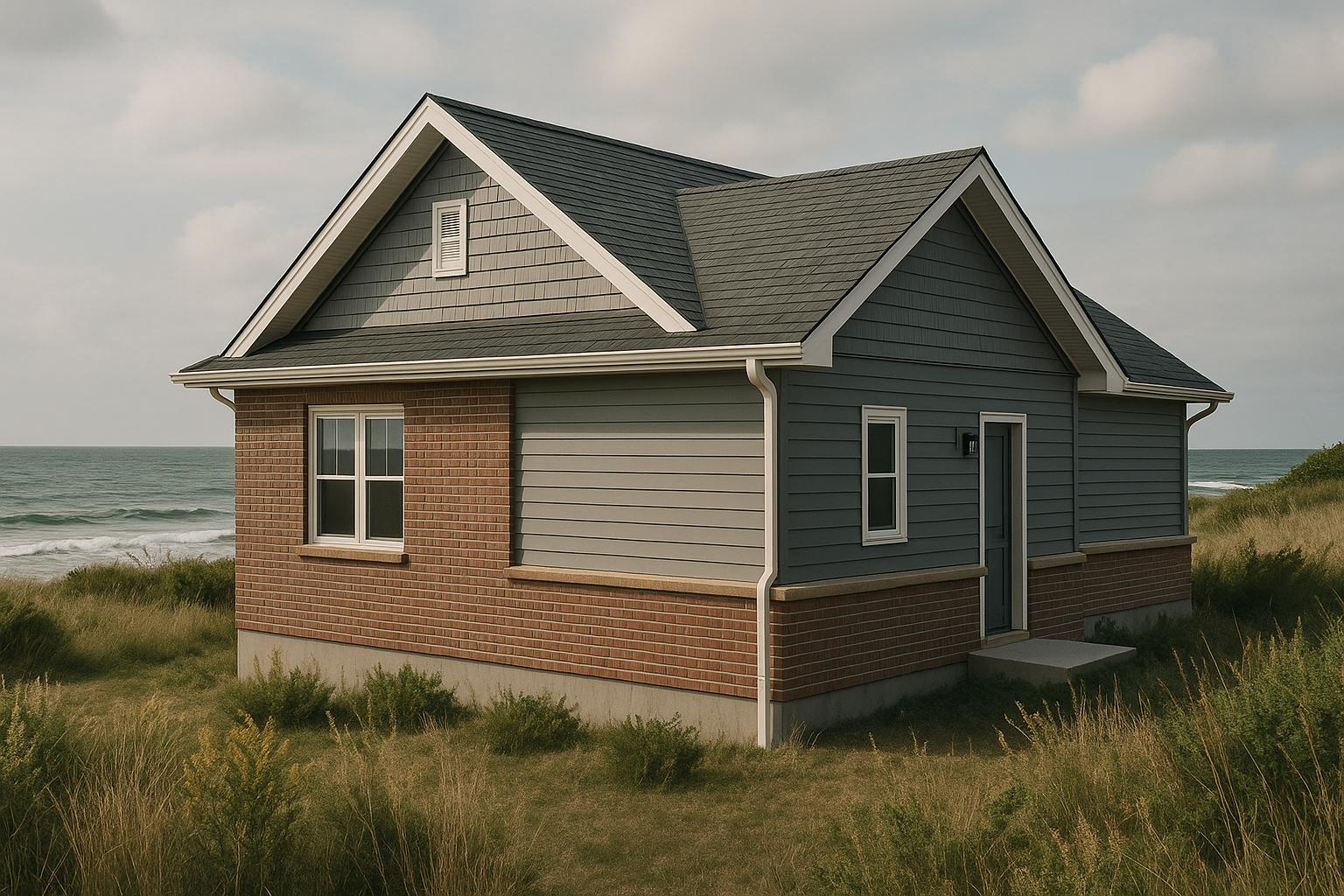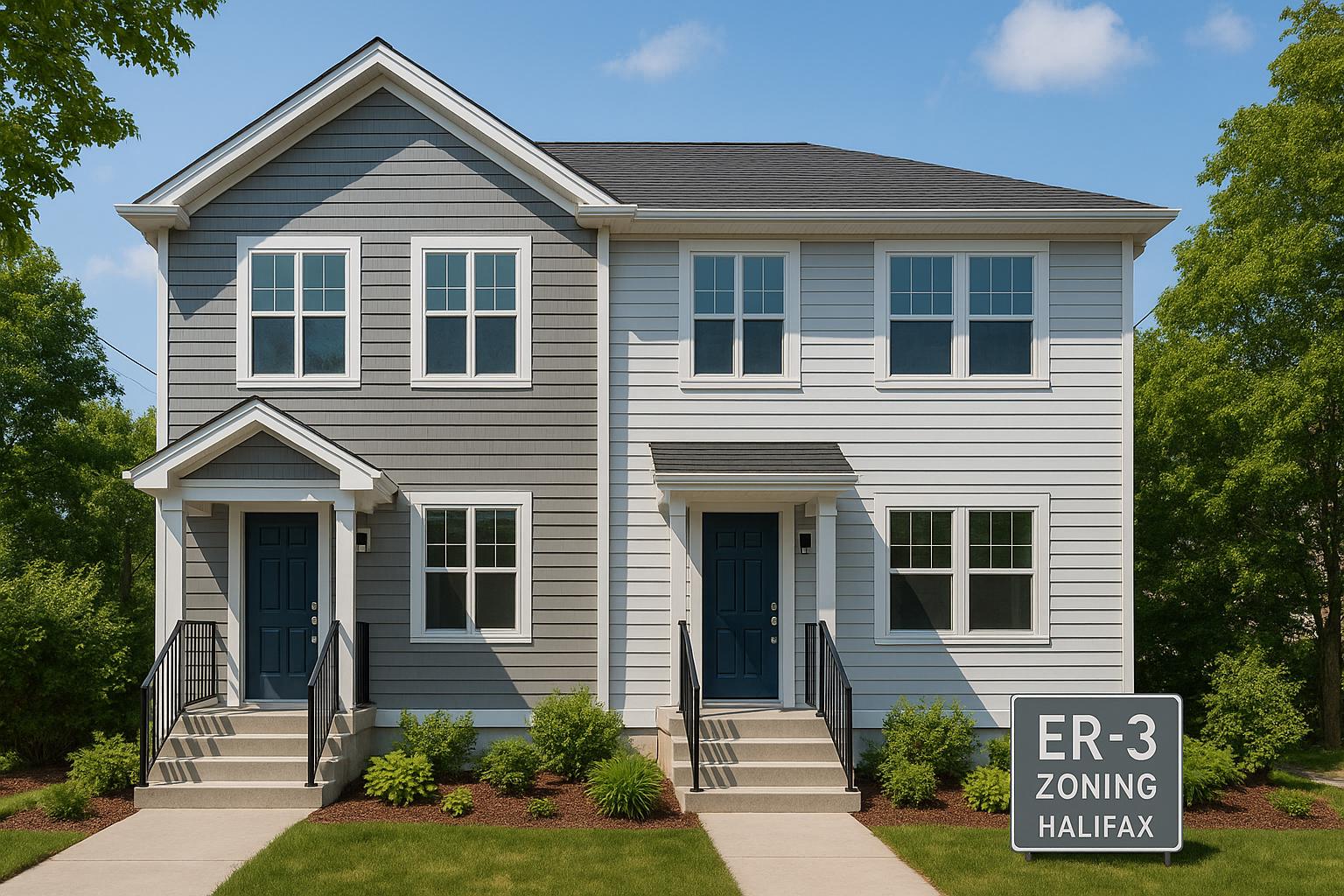Construction delays in Nova Scotia can cost you thousands in lost rental income and budget overruns. A 4-unit property, for example, could lose $7,800–$8,400 per month in missed rent, with delays often pushing timelines from 8 months to 18 months. Poor communication, fragmented teams, and unpredictable weather are common culprits.
To avoid these issues, here’s what works:
- Use fixed-price contracts with penalty clauses (e.g., $1,000/day for delays).
- Choose design-build companies to streamline planning, construction, and communication.
- Set clear milestones with deadlines for each phase (e.g., foundation, framing).
- Leverage digital tools for real-time updates and progress tracking.
These strategies ensure your project stays on track, minimizing delays and protecting your investment.
How To Avoid Delays In Construction Projects
What Causes Construction Delays in Nova Scotia
One major reason for delays in multi-unit home construction is the lack of proper communication between independent teams. When teams work in isolation without shared accountability, scheduling conflicts and disruptions can arise, leading to costly setbacks. This fragmented way of working often creates unnecessary challenges.
Poor Communication Between Construction Teams
Scheduling conflicts are a common issue when tasks aren’t properly coordinated. For example, if design changes aren’t shared or material delays aren’t communicated, the entire timeline can be thrown off, causing a ripple effect of delays throughout the project.
To address this, teams need to focus on clear communication practices. Regular check-ins, active listening, and standardized documentation can help align everyone involved. Establishing clear protocols ensures that updates - such as design changes, material orders, or schedule adjustments - are shared across all teams. This reduces mistakes and keeps the construction process running smoothly.
Improved communication is just one step toward preventing delays in Nova Scotia’s construction projects, but it’s a critical one.
How Design-Build Companies Prevent Delays
When it comes to construction, the traditional approach can often feel like trying to piece together a puzzle without a clear picture. Property owners typically hire separate companies for planning, architecture, engineering, and construction, each working independently. This fragmented process tends to create miscommunication and delays that stretch project timelines unnecessarily.
Design-build companies take a different route, simplifying the process by combining all these services under one roof. Instead of juggling multiple contracts and relying on different teams to stay in sync, property owners work with a single company that handles everything - from the initial designs to the final build.
One Team, One Plan
By managing planning, architecture, engineering, and construction as a unified operation, design-build firms eliminate the blame game that often arises when something goes wrong. They tackle potential issues, like permitting or weather-related disruptions, early in the planning stage, reducing the risk of costly last-minute adjustments [1].
This streamlined approach ensures seamless communication among all teams. When design changes occur, they’re shared instantly because everyone works under the same umbrella. Material orders and construction schedules are aligned, as one project manager oversees the entire process. Even weather-related delays are accounted for in the initial timeline, turning potential surprises into manageable challenges.
This kind of coordination is especially valuable in areas like Nova Scotia, where winter weather and strict municipal permitting can pose unique challenges. Design-build companies adjust project timelines and specifications early on to address these regional factors, helping avoid unnecessary delays.
Why Property Owners Benefit
For property owners, the design-build model offers three key perks: fixed pricing, unified schedules, and single-point accountability. These directly address common issues like cost overruns and timeline mismatches.
- Fixed pricing means no unexpected budget surprises.
- Unified schedules ensure that everyone works toward the same deadline. Unlike traditional projects where architects, engineers, and contractors may each have conflicting timelines, design-build firms create one master schedule that keeps everything on track.
- Single-point accountability simplifies problem-solving. Property owners have one point of contact for the entire project, eliminating disputes between contractors over who’s responsible for delays.
These benefits don’t just save time - they save money too. Traditional construction projects often run 30-60% over budget due to miscommunication and poor coordination. Design-build firms avoid these pitfalls, delivering projects on time and within budget.
For property owners, this means rental income can start flowing sooner. By cutting through the typical coordination headaches, design-build companies make it possible to get tenants in the door faster. Up next, we’ll explore how clear milestones and effective scheduling tools further ensure projects stay on track.
sbb-itb-16b8a48
Creating Clear Milestones and Using Scheduling Tools
Breaking construction projects into well-defined phases with specific deadlines helps keep progress measurable and manageable. By setting clear milestones, property owners can spot issues early and ensure steady progress.
Breaking Projects into Clear Phases with Deadlines
Construction projects naturally fall into distinct stages, each with its own deliverables and timeline. These stages - like foundation work, framing, rough-ins for electrical and plumbing, insulation, drywall, and finishing - act as checkpoints to measure progress.
Instead of relying on vague timelines, property owners should establish firm deadlines for each phase. For example, aim to complete the foundation by the third week, framing by the seventh, and rough-ins by the tenth. To enforce these deadlines, consider including daily penalties, such as $1,000 per day, for delays. This ensures all parties involved are contractually accountable.
Each milestone should outline specific deliverables and quality benchmarks. For instance, completing the foundation doesn’t just mean pouring concrete - it also includes proper curing time, passing municipal inspections, and receiving formal approval to move forward. This level of detail reduces the grey areas where delays often arise.
It’s also essential to consider local weather conditions when planning indoor and outdoor work to avoid unnecessary setbacks.
Once these clear deadlines are in place, digital tools can be used to provide real-time tracking and ensure the project stays on schedule.
Digital Tools for Tracking Construction Progress
Digital platforms offer real-time updates, removing the guesswork from monitoring daily progress.
Features like daily photo updates and integrated scheduling systems help identify potential delays early. Advanced scheduling tools also track trade dependencies, highlighting any issues that could disrupt subsequent phases. This proactive approach allows for quick adjustments, reducing the need for last-minute crisis management.
Visual dashboards make it easy to compare progress against the original timeline. Many use colour-coded indicators - green for on track, yellow for potential issues, and red for urgent problems - making it simple to assess the project’s status at a glance. These tools even allow property owners to monitor progress remotely.
When scheduling tools are linked with financial tracking systems, they provide a clearer picture of how delays might impact costs. For instance, a delay in a critical phase could push back the start of rental income, emphasizing the financial importance of meeting deadlines.
Contract Types and Guarantees That Prevent Delays
In addition to setting clear milestones and using digital tools for tracking, the way your contract is structured plays a big role in keeping your project on schedule. Just like milestones help measure progress, contract terms hold everyone accountable. The type of contract you choose can make the difference between staying on budget and timeline or dealing with costly delays. Opting for a less-controlled contract could leave property owners facing extended timelines and skyrocketing costs.
Fixed-Price vs Cost-Plus Contracts
Fixed-price contracts offer a set construction cost that’s agreed upon before the project begins, giving you a clear and predictable budget. For example, a builder might quote $640,000 for a fourplex, and that price remains unchanged regardless of shifts in material or labour costs. This arrangement shifts financial risk to the builder, encouraging efficient management. Knowing they’ll absorb any cost overruns, builders are more likely to source materials carefully, coordinate trades effectively, and stick to the timeline. The result? A more predictable budget and quicker project completion.
Cost-plus contracts, on the other hand, pass every expense directly to the property owner. You pay for the actual labour and materials, plus an additional fee to the builder. This structure reduces the builder’s motivation to control costs or meet deadlines. It often leads to “scope creep,” where the project grows beyond its original scope, inflating the budget. Without the pressure of a fixed price, builders may take longer to complete the work, and delays can eat into potential rental income.
| Contract Type | Cost Certainty | Timeline Certainty | Owner Risk | Common in NS Multi-Unit? |
|---|---|---|---|---|
| Fixed-Price | High | High | Low | Common |
| Cost-Plus | Low | Low | High | Rare |
In Nova Scotia, where the housing market averages around 5,450 housing starts annually but needs to more than double that to meet demand [2], avoiding delays is crucial for property owners aiming to maximize rental opportunities.
The choice between these contracts also determines how penalties and guarantees are applied, ensuring builders stay on track.
Daily Penalties Keep Contractors on Schedule
Daily penalty clauses are a powerful tool for keeping contractors focused on your project. These clauses impose financial penalties - sometimes up to $1,000 per day - for failing to meet agreed deadlines. This not only compensates property owners for lost rental income but also motivates builders to prioritize your project. When contractors face financial consequences, they’re less likely to shift resources to other jobs and more likely to resolve issues like weather delays or permit problems quickly.
| Guarantee Type | Description | Owner Benefit |
|---|---|---|
| Liquidated Damages | Daily penalty for late completion | Covers financial losses from delays |
| Completion Guarantee | Builder guarantees delivery by a set date or pays a penalty | Reduces risk of delays |
Key contract clauses to include are detailed milestones, clear definitions of the scope of work, and procedures for managing changes. These elements help prevent disputes and ensure that any modifications don’t derail the project’s timeline or budget.
The most effective penalty structures align directly with your financial losses. For instance, if your fourplex would generate $7,800 in monthly rent, a $260 daily penalty ($7,800 ÷ 30 days) ensures that any delay is fairly compensated. This approach not only motivates builders but also ensures the penalty reflects your actual losses.
For property owners, penalty-backed guarantees are essential. They fundamentally shift how builders manage projects, encouraging better scheduling, efficient trade coordination, and quick problem-solving when issues arise. By tying financial consequences to missed deadlines, you ensure that your project stays on track and your investment is protected.
Conclusion: Building On Time and On Budget in Nova Scotia
Avoid construction delays in Nova Scotia by adopting a design-build approach, setting clear milestones with real-time tracking, and securing fixed-price contracts that include penalties for missed deadlines.
With Nova Scotia needing to double its annual housing starts to roughly 12,540 units per year until 2035 [2], the stakes are high. Every delay can mean lost rental income, especially as demand continues to outpace supply.
The integrated design-build model streamlines the process by replacing multiple contracts with a single, unified team. This eliminates communication gaps that can turn an 8-month project into an 18-month ordeal. Digital tracking tools and well-defined project phases give you real-time updates, helping you spot and address potential delays before they escalate. When paired with fixed-price contracts that include daily penalty clauses - sometimes as much as $1,000 per day - these measures ensure that delays are rare and quickly resolved. Contractors facing financial penalties for missed deadlines have a strong incentive to stay on schedule.
For property owners, these strategies safeguard both your rental income and the value of your investment. Penalty clauses hold contractors accountable, compensating you financially for any delays. Choosing builders who provide guaranteed timelines, transparent pricing, and penalty-backed completion dates ensures your project stays on track, protecting your bottom line.
In Nova Scotia's competitive rental market, relying on a fragmented approach is not an option. Delivering projects on time and within budget is critical to maximizing returns. By adopting these strategies, property owners can meet housing demand challenges head-on and ensure their investments pay off.
FAQs
How do fixed-price contracts with penalty clauses help keep my Nova Scotia home build on schedule?
Fixed-price contracts with penalty clauses can be a smart way to keep your home build on schedule. These agreements lock in a set price for the project and include financial penalties for missing deadlines - like charging a daily fee for each day the work runs late.
This setup shifts the burden of delays from you, the homeowner, to the contractor. It pushes them to stick to the agreed timeline, encouraging better planning and coordination. For your Nova Scotia build, this can mean fewer setbacks and a smoother process overall.
What are the benefits of choosing a design-build company for multi-unit construction in Nova Scotia?
Choosing a design-build company for your multi-unit project comes with several clear benefits. When one team manages both the design and construction phases, communication becomes more straightforward. This reduces delays that can arise from miscommunication or the need to coordinate multiple contracts. The result? Projects are completed more efficiently, with tighter cost management and greater accountability.
With all responsibilities under one roof, design-build firms offer property owners more predictability and fewer unexpected issues during construction. This streamlined process is especially helpful in Nova Scotia, where permitting requirements and unpredictable weather can complicate traditional construction methods.
How can digital tools improve communication and scheduling to keep construction projects on track?
Digital tools are game-changers when it comes to keeping construction projects on track. They simplify communication, bring all project details into one place, and use real-time updates and visual scheduling to make managing tasks and resources much easier. These tools not only cut down on mistakes but also ensure everyone - whether on-site or in the office - is on the same page, leading to smoother teamwork.
By adopting these tools, you can establish clear timelines, monitor progress more efficiently, and tackle delays before they escalate. For property owners in Nova Scotia, this means staying on schedule and protecting their rental income potential.
Related Blog Posts
- The Nova Scotia Home Build Blueprint: Step-by-Step Guide from Planning to Move-In
- How Long Does It Take to Build a House in Nova Scotia? Timeline Explained
- From Permits to Move-In: The Custom Home Building Timeline in Nova Scotia
- How Long Does It Take to Build a House in Nova Scotia? A Step-by-Step Timeline



